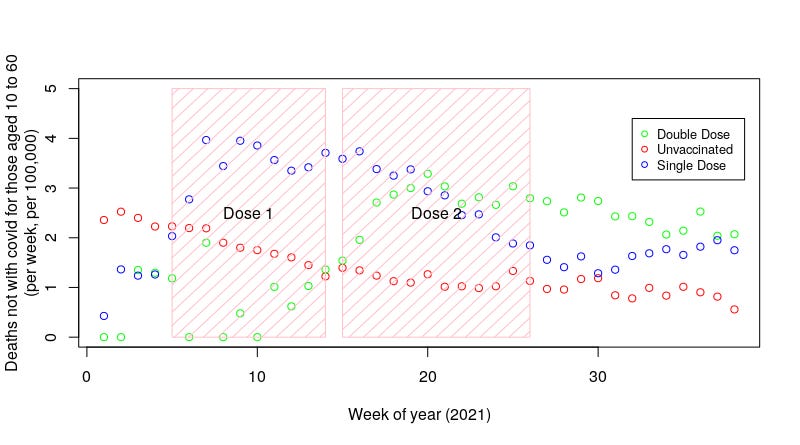On the impact of the vaccines on non-covid deaths [Part 3]
I'll end with a warning about data analysis.
Even worse, one particular aspect of the data has been going around the internet, and this aspect relates to the data I’ve not touched on.
The data I’ve not discussed yet is the deaths data for those aged 10 to 59, and the aspect of the data that is interesting people is:
Age specific death rate per 100,000 per week for all causes of death, for individuals aged 10 to 59, for the week ending 24th September:
Unvaccinated: 0.9
Double vaccinated: 2.2
But surely this is the most important aspect of the data so far! This quite clearly says that the young double vaccinated are 2.5 times more likely to die than the unvaccinated! The vaccines are killing people! Why on earth would I leave such a bombshell until last?
Well, that’s exactly what the data says — and other weeks in the latter part of the data set show a similar effect — but once we analyse the data perhaps you’ll agree that it is actually the least interesting aspect of this data set, not the most interesting. At the same time, we can explore how taking data at face value without trying to understand what lies beneath can be dangerous.
I think we need a graph to help explain this apparent conundrum. Here’s a graph for all non covid deaths for those aged 10-59, by vaccination status and week of death:
That’s a bit of a mess, but I think it is readily explainable and I don’t think it shows that the vaccines are killing the vaccinated in great numbers.
The red circles shows deaths in the unvaccinated. They start off at around 2.5 deaths per week at the start of 2021 and decline to around 0.7 deaths per week by the final data point (for the week ending 24th September).
What is happening isn’t the death rate declining, so much as older age groups moving out of the unvaccinated group as the age range for vaccination gradually declines; at the start of the year the unvaccinated group contains all individuals aged 10 to 60, while by the end of the data series the unvaccinated group is dominated by those aged under 25.
The crucial point here is the strong correlation between age and risk of death (at least for those aged above 10) — those in the higher range of that wide age group might be significantly less likely to die than those aged 70 (for example), but nevertheless they’re far more likely to die than those at the younger end of that wide age group. Thus the steady decline in death rate in the unvaccinated group is exactly what would be expected.
With that in mind, the deaths data for first and second dose of vaccine make sense (blue circles and green circles respectively). Before the general roll out those vaccinated in the 10 to 60 age group were dominated by healthcare workers of all ages. As routine vaccination starts we see a rapid rise in death rates, as the vaccine group starts to become dominated by those at the upper range of those aged 10-60. After that point we see a slow decline in death rates as the vaccinated group becomes filled with younger individuals.
The data in the graph is for non-covid deaths, but the same effect is seen for covid deaths — while the data look as though they’re telling us a story, they’re actually misleading us.
So, those data that I mentioned right at the start? The age specific death rate per 100,000 for all causes for individuals aged 10-59 for the week ending 24th September?
Unvaccinated: 0.9
Double vaccinated: 2.2
Well, now we should be able to see that isn’t at all interesting; it merely says that the double vaccinated are on average older than the unvaccinated group. As much as I’d like it to say more, it just doesn’t.
Does that make me pleased? Not at all. The data that have been released regarding covid in general, and the vaccines in particular, has been of dreadful quality. Often it gets so close to offering some value, but then it turns out that the data is useless. This is yet another example of that. I have no idea why a statistics group would collate data from such a wide age range, when the main variable, the people who are being vaccinated, has such a strong age dependency. They could have provided data by 10 year interval, like for the older age groups, but they decided not to. Perhaps they’re trying to hide something…
I’ll end with another note of caution. I started off with the suggestion that the vaccines might be causing people to die, and then showed how these data do not, in fact, indicate this. But I absolutely, most definitely, haven’t shown that the vaccines are safe and aren’t causing people to die, especially in the younger age group; the data don’t support this interpretation either. If the ONS had offered these data by 10 year intervals then we might have been able to see if the vaccines were increasing mortality in the younger age ranges, but they didn’t split up the data in this way and as a result there is little hope of finding anything useful for this age range.
Anyway, that’s why I’ve not discussed the data for those aged 10-59 in this series of posts — these data are dominated by an age effect that can’t be compensated for, and is pretty much useless.
The Post-Partisan Emporium's

Comments
Post a Comment